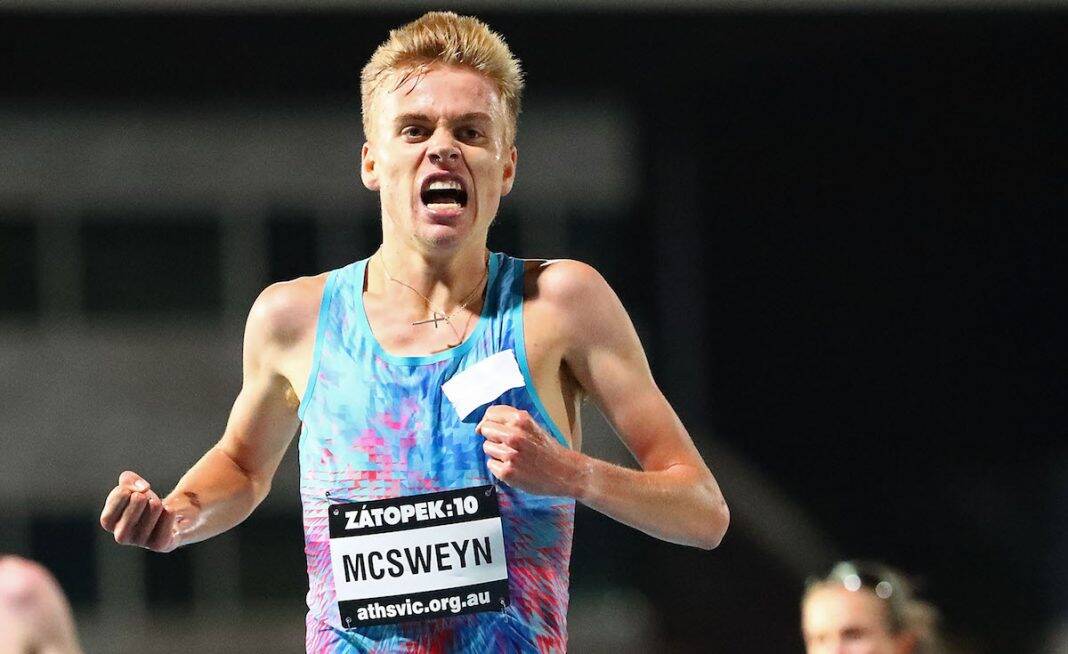I went to the 2018 Zatopek meeting with two expectations – first, that we were in for a drenching; second, in diminishing order of likelihood, that Stewart McSweyn would run a world championships qualifier, the fastest time by an Australian in race history, break the national record, break the race record – perhaps all four.
Some hours later I headed back home, my waterproof jacket and umbrella still in my backpack, and the 27:40 Doha standard, Shaun Creighton’s 27:31.92 former national record from 1996, Ben St Lawrence’s current national record 27:24.95 from 2011 and Luke Kipkosgei’s 27:22.54 from 1998 all still intact.
Strangely, none of that diminished my enjoyment of the two Zatopek races. The women’s race was enlivened by the performance of Hitomi Niiya, a fifth-place finisher in the 2013 world championships, who ran the third-fastest women’s winning time (and fourth-fastest overall) in race history.
And if Stewart McSweyn did not hit any of his ambitious time targets, he won the men’s race for the second consecutive year, becoming the first Australian to produce back-to-back winning performances since Steve Moneghetti in 1991 and 1992 (actually, that was part of a four-peat by ‘Mona’ from 1989 to 1992, three back-to-backs one after the other. So, Stewie still has some work to do).
View this post on Instagram
McSweyn also capped an impressive year which has brought PBs across the whole range of track distances – a 3:34.82 1500 (10th all-time Australian), a 3:54.60 mile (11th), a 7:34.79 for 3000 (2nd), a 13:05.23 for 5000 (also 2nd) and, now, a 27:50.89 for 10,000 (14th). That’s more than enough to assuage any minor disappointment at the Zatopek result.
Getting back to the weather, Zatopek day in Melbourne dawned with Australia’s southernmost mainland state, undergoing the race experience of being impacted by a tropical cyclone weather system. Most of the eastern seaboard was enduring heavy rainfalls as tropical cyclone Owen reversed course to hit the coast of northern Queensland.
Melbourne had its average total December rainfall in one day. Many rural areas of the state suffered more severe rain events. Miraculously, though, the Zatopek meeting proceeded in dry conditions, the only impact of the rain being a slightly-elevated level of humidity.
Having gone to Lakeside Stadium conjuring up images of Paula Radcliffe splashing her way through a Munich rainstorm to the world’s third-fastest 10,000 in history in 2002, or a mud-splattered Bob Schul sprinting to victory in the 5000 metres in the last Olympics contested on a cinders track in Tokyo in 1964, I was more than happy to settle for fine, cool and slightly windy conditions (pretty sure the Zatopek contestants were, too!).
Hitomi Niiya’s participation in the women’s Zatopek was announced pretty much on race day. Though she may have arrived largely on the quiet, Niiya didn’t take long to make a resounding impression. Prominent towards the front of the pack as Melissa Duncan and Genevieve LaCaze took the field through the first five laps, Niiya burst to the front soon after that and simply ran away with the race.
Niiya’s winning time of 31:32.50 was the third-fastest winning time in Zatopek history, just 6.40 second slower than Joyce Chepkirui’s race record set in 2011. Hardly surprising, perhaps, given Niiya was fifth placegetter in the 2013 world championships after leading for much of the race.
The surprising thing was that Niiya was running at all. Still only 30 years old now, she had retired less than a year after Moscow, frustrated over her inability to overcome a chronic plantar fascia injury which had dogged her for more than a year. Her retirement press conference appeared to slam the door tight on any return: “I can’t imagine what I’ll be doing,” she had said, “but I will completely cut off connection with the world of athletics.”
Four years later, Niiya is back with an eye on making the team for a home Olympic Games at Tokyo 2020.
Niiya is coached by Masato Yokota, a former Japanese record holder at 800 metres who was a member of Santa Monica Track Club where he, in turn, was coached club founder and Carl Lewis’s long-time manager, Joe Douglas. Douglas was a middle-distance runner himself and, despite the presence of great sprinters Lewis and Leroy Burrell, Santa Monica always had some handy middle-distance types on its books.
Although 100 metres behind Niiya at the finish, Sinead Diver continued her amazing run of form this year to take the Australian title with 31:50.98, the sixth-fastest women’s time run in the Zatopek, while minor medallists Ellie Pashley (32:17.81) and Emily Brichacek (32:22.38) both ran substantial PBs, Pashley by over two minutes.
Niiya and Diver pushed three-time champion Eloise Wellings out of the all-time Zatopek women’s top-10, while Diver’s time was the fastest by an Australian woman at the Zatopek since Susie Power in 2001.
Progress was less spectacular in the men’s race. McSweyn’s winning time was some 15 seconds faster than his previous best, while Rayner – who had not lost a race since the Commonwealth Games selection trials – slashed just over 47 seconds off his previous best in finishing second in 28:12.07. Jack Bruce, currently at the University of Arkansas, took the national championship bronze medal.
The 2018 version may not have been one of the greatest of the 58 Zatopek meetings, but Niiya and McSweyn ensured it had more than its share of great moments.
